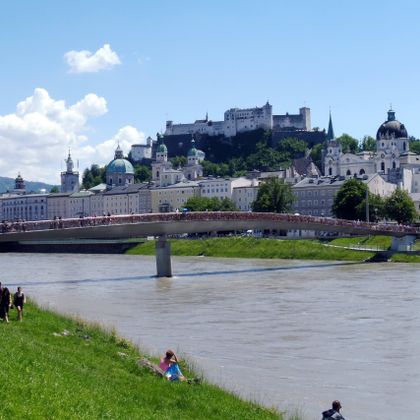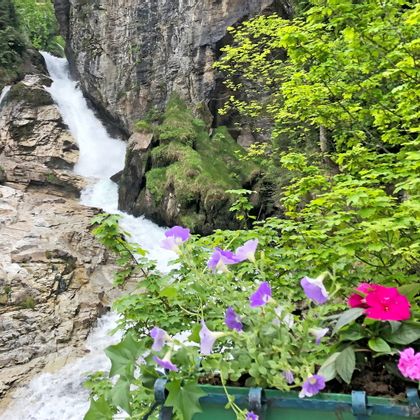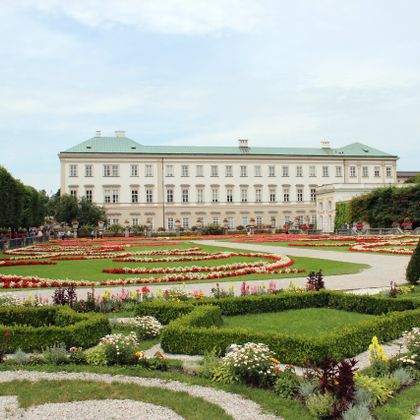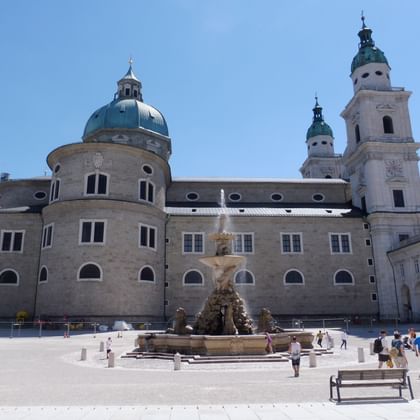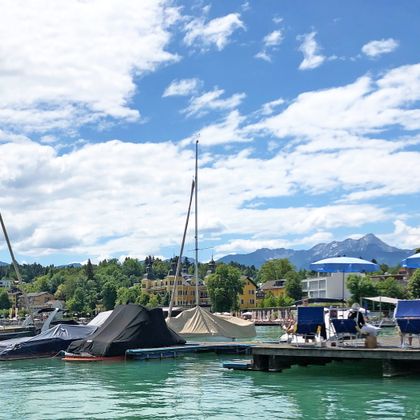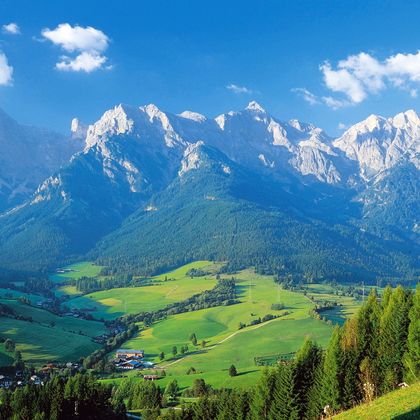Tour
Look forward to the city of Salzburg. There are winding alleys, places to stroll, dreamy cafes with real Austrian coffee specialties, colorful culture and diverse history at every turn.
Through meadows along the Salzach, you cycle leisurely from Salzburg south to Hallein. Take a break here in the medieval heart of the city. Stroll through the narrow streets and across the wide squares of the historic salt and Celtic city. Hallein will surprise you with a romantic old town, historic archways and houses with magnificent facades. Continue past the rushing waterfall and Golling. On the well-developed Salzach cycle path, you cycle almost always directly along the riverside to St. Johann. Unmistakable - like double mountain peaks - the towers of the Pongau Cathedral can be seen from afar. Look forward to the town and enjoy the special atmosphere of this little shopping paradise. Whether modern or traditional, friendly shops invite you to browse, cozy inns and inviting restaurants promise a nice evening.
You cycle 7 kilometers by bike along the Salzach river to Schwarzach. From here, the river Gasteiner Ache accompanies you through the wild and romantic Gastein Valley. Via Dorfgastein and Bad Hofgastein you continue through the Hohe Tauern National Park to the well-known spa and winter sports resort Bad Gastein. Marvel at the impressive villas from the Belle Époque period that were built on the steep slopes. Surrounded by peaks that tower above the three-thousand-meter mark, Bad Gastein is the Monte Carlo of the Alps! Take a worthwhile break here and marvel at the narrow center that has emerged around the waterfall. The total fall of the Gasteiner Ache is 341 m and is spread over three steps. Then you cycle another 4 km to the train station in Böckstein. You use the train, which takes you comfortably to the other side of the Alps to Mallnitz in just 10 minutes. Look forward to your bike route in the Mölltal, because a rushing descent will get you there fast.
Enjoy the Möll valley, which got its name from the Möll river. The Möll rises on the Großglockner and flows into the Drau only 80 km later. Let yourself be fascinated by the wild water of the Möll and the impressive alpine mountain landscape. Look forward to the Drau valley, because this is where the sunny south of Austria begins. Almost by itself, your bike will bring you downhill along the Drau. Visit Porcia Castle in Spittal, because it is one of the most important Renaissance buildings in Austria! Then you cycle along the riverbanks of the Drau from one small highlight to the next. You can explore excavations of an early Christian church near Molzbichl, an archeology museum and the Dobratsch nature park near Villach. Stroll through Villach in the afternoon and discover the old streets and idyllic arcaded courtyards. Enjoy the pulsating life of the more than 800-year-old trading town and visit the late Gothic parish church, one of the most beautiful hall churches in the country.
You can bypass the ascent to Tarvisio by train. In Italy, too, the cycle path is well developed and so you cycle comfortably downhill through the Canal Valley and admire the beauties of the Friulian Alpine region with untouched nature and extensive forests from the saddle. One of the pretty villages at the foothills of the Julian Alps will be your hotel.
Almost the same route as the iron which was transported in the 15th century, today you will follow the course of the Tagliamento before turning shortly after Gemona towards Udine. But first take a break in Gemona, because it is one of the most beautiful historical places in Friuli Venezia Giulia. Marvel at the beautiful facade of the Santa Maria Assunta Cathedral and stroll through the narrow streets of the old town. In 1976 Friuli was hit by a severe earthquake (Richter scale 6.5), the epicenter of which was near Gemona. Gemona and the neighboring communities of Venzone and Osoppo were almost destroyed. The right aisle and the campanile of the famous cathedral Santa Maria Assunta (Holy Mary Assumption) collapsed. Everything has been rebuilt as well as possible, including the campanile (bell tower), but the columns in the cathedral are still a bit crooked. Then you cycle back and forth through fields and meadows from one village to the next. Look forward to Udine, a small town with flair, where “dolce vita” can be felt. In Piazza della Liberta, one of the most beautiful squares in northern Italy, you can marvel at the Palladio Gate and the Venetian clock tower, and don't miss out on having an espresso or cappuccino here. Stroll through the historic center, marvel at the cathedral and the Castello on the hill above the city.
Today you cycle through wide reed landscapes and along small water channels towards the Gulf of Venice. Take a break in the small town of Palmanova (approx. 5500 inhabitants), which was laid out as a planned town and bastion at the end of the 16th century and whose star-shaped layout has been preserved to this day. Special planning features were once relatively wide, regular streets so that the soldiers could get from the center (parade ground) to the defensive fortifications (city walls) as quickly as possible. On your cycle route to the Adriatic coast, you should definitely stop in Aquileia. The historic Roman city has been a UNESCO World Heritage Site since 1998. Remains of the Roman city have been partially uncovered, such as the forum and the inland port. In Aquileia, you can also visit the medieval basilica from the 11th century, which is famous for its early Christian floor mosaics. The mosaics are among the most important in the country! Now it's only about 10 km to Grado. Look forward to one of the most popular seaside resorts on the Adriatic with an extensive sandy beach and a historic fishing town. End the evening and your trip in the narrow streets with cozy restaurants and Italian flair.
If you would like to spend more relaxing days on the Adriatic, you are welcome to book additional nights in Grado.
Map
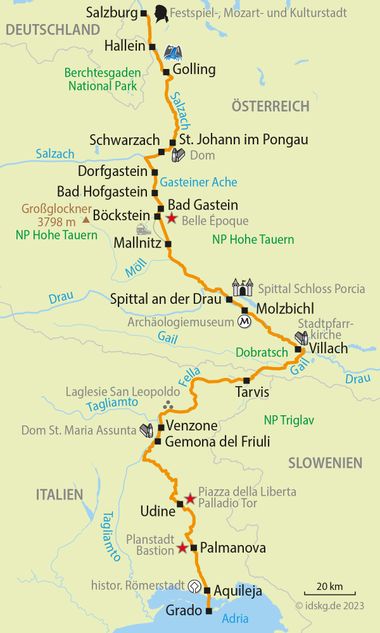
Prices / Dates
Services / Info
- Accommodation incl. breakfast in 3- and 4-star hotels
- Room with shower/bath/WC
- Luggage transport
- Personal tour information
- 1 train ride Böckstein - Mallnitz incl. bike
- 1 train ride Villach - Tarvis incl. bike
- Digital route guidance via smartphone app
- Tips for tour preparation
- Touristic information
- 7 days hotline service
Below you will find specific information about the individual bike tour Salzburg - Grado. If you have any further questions about this trip, just give us a call: Phone: +49-(0)6421 - 886890.
Arrival by car
There are tolls and motorway fees in Austria. A vignette is required. You can buy vignettes online or at petrol stations just before the border or at the border.
Arrival by train
The best way to get to our partner hotels in Salzburg from the Salzburg main station is a short taxi ride. Current timetable and price information can be found at: Train schedule information Deutsche Bahn and Train schedule information ÖBB
Parking facilities at the hotel
Some of the arrival hotels have parking spaces that cannot be reserved in advance. Costs approx. € 12.00 - 15.00 per day. Public car parks are a good alternative to hotel parking spaces. The costs are approx. € 80.00 - 115.00 per week. You will receive detailed information on parking at the hotel booked for you with the detailed travel documents two weeks before the start of your journey.
Condition of the bike paths
You mainly cycle on well-developed bike paths and quiet side streets. Only a few sections lead on roads with heavy traffic or unpaved roads. Overall, the route is slightly hilly, although the most demanding section between St. Johann and the Gastein Valley can be avoided by train.
Tour information and rental bike handover
The personal tour information with subsequent bike handover takes place on the day of arrival between 5 pm and 7 pm. The exact time will be announced by the reception upon arrival. If you do not want to take part in the tour information, documents and rental bikes will be deposited at the arrival hotel. A short message in advance is very welcome!
Available rental bikes
For this trip, you can choose between 21/24-speed unisex bikes with derailleur gears in various frame heights and 8-speed electric bikes. Simply let us know your bike preference when booking.
Transfer back to the starting point
You can book an organized return transfer from Grado to Salzburg in advance. The return transfer is available every Thursday, Friday, Saturday, and Sunday morning. The journey takes approximately 5.5 hours, depending on traffic conditions.
Alternatively, a return journey by train from Grado to Salzburg is only possible with several changes.
Cycling in Austria and Italy
Helmets are not compulsory in Austria, but wearing a helmet is highly recommended. Since 2011, cyclists in Italy have been obliged to wear safety vests in rural areas during the night (half an hour before sunset to half an hour before sunrise). In addition, luminous vests are mandatory as soon as you cycle in tunnels with road traffic.
Weather / climate
The climate in Austria can be assigned to the humid-warm temperate zone. The ideal travel time for cycling is therefore spring, summer and autumn. Northern Italy is still in the Central European climatic area (cold winters). The subtropical transitional climate begins from the Po Plain down. The middle and south of the country are characterized by mild, humid winters and dry, hot summers. During the summer months, it is advisable to pack light, easily washable clothes, and light woolen clothes should not be missing in your luggage for the evenings. For the rest of the time, transition clothing and warmer woolen clothes are recommended.
Extra costs that are not included in the tour price
Any tourist tax and charging fees for bicycle batteries are not included in the tour price and must therefore be paid at the hotel.
7 day hotline service
In case of chain breakdown, flooding or other bad surprises that makes a continuation of your tour impossible: no problem, we also work during weekends and you can reach us 7 days a week in case of emergency.
Passport and visa requirements
For EU citizens, there are no special passport or visa requirements and no health formalities to be considered for this trip.
Travel insurance
The tour price already includes the statutory insolvency insurance. In addition, we recommend that you take out travel cancellation insurance upon receipt of your travel confirmation in order to protect yourself against financial disadvantages in the event of travel cancellation, interruption of travel, illness or accident.
For this trip, we recommend using digital travel documents in the interest of sustainability. However, if you prefer, you can choose printed travel documents with a cycling map during the booking process.
Please note that price differences may apply depending on your selection.

I provide you with advice and assistance
Christine Jockel
